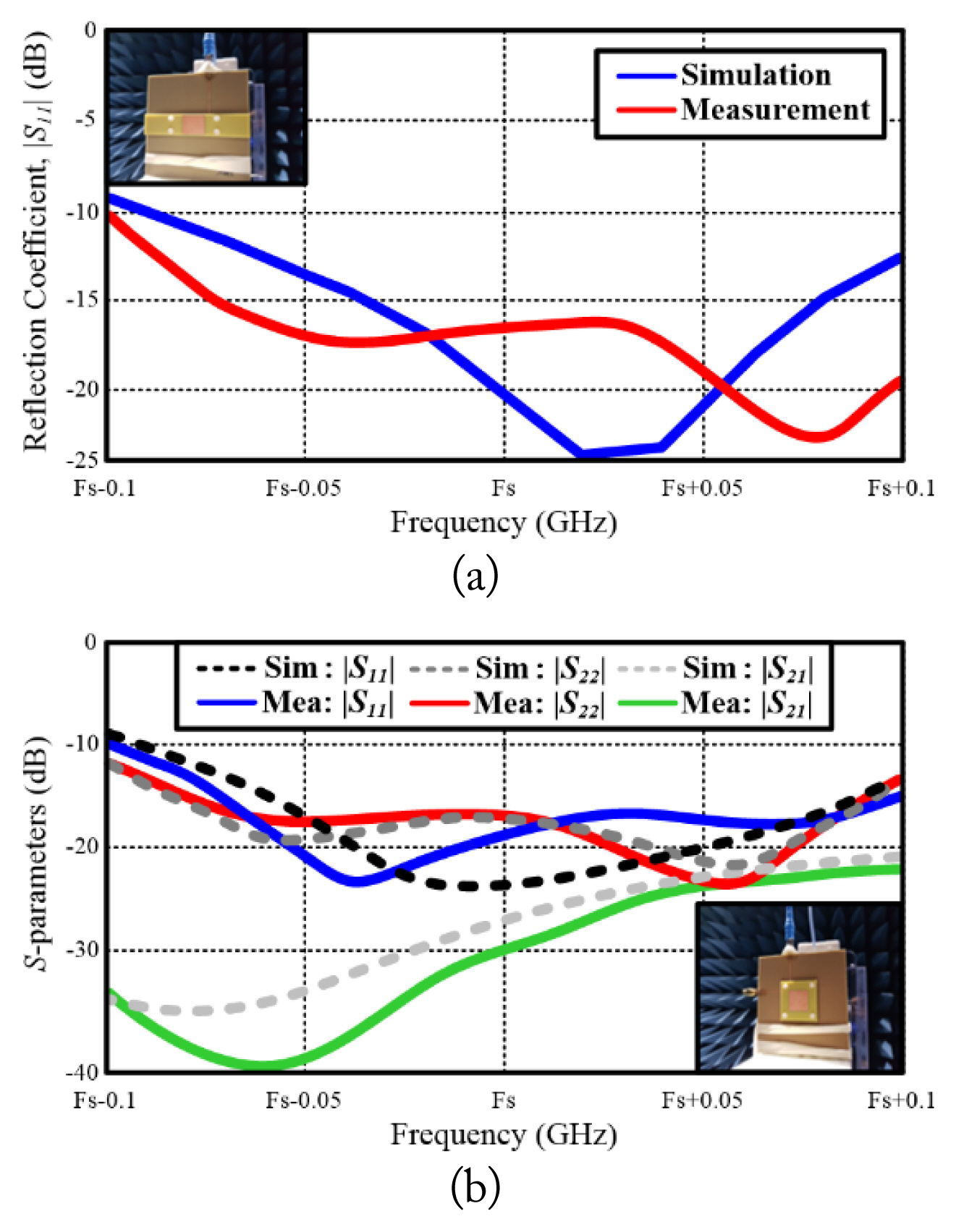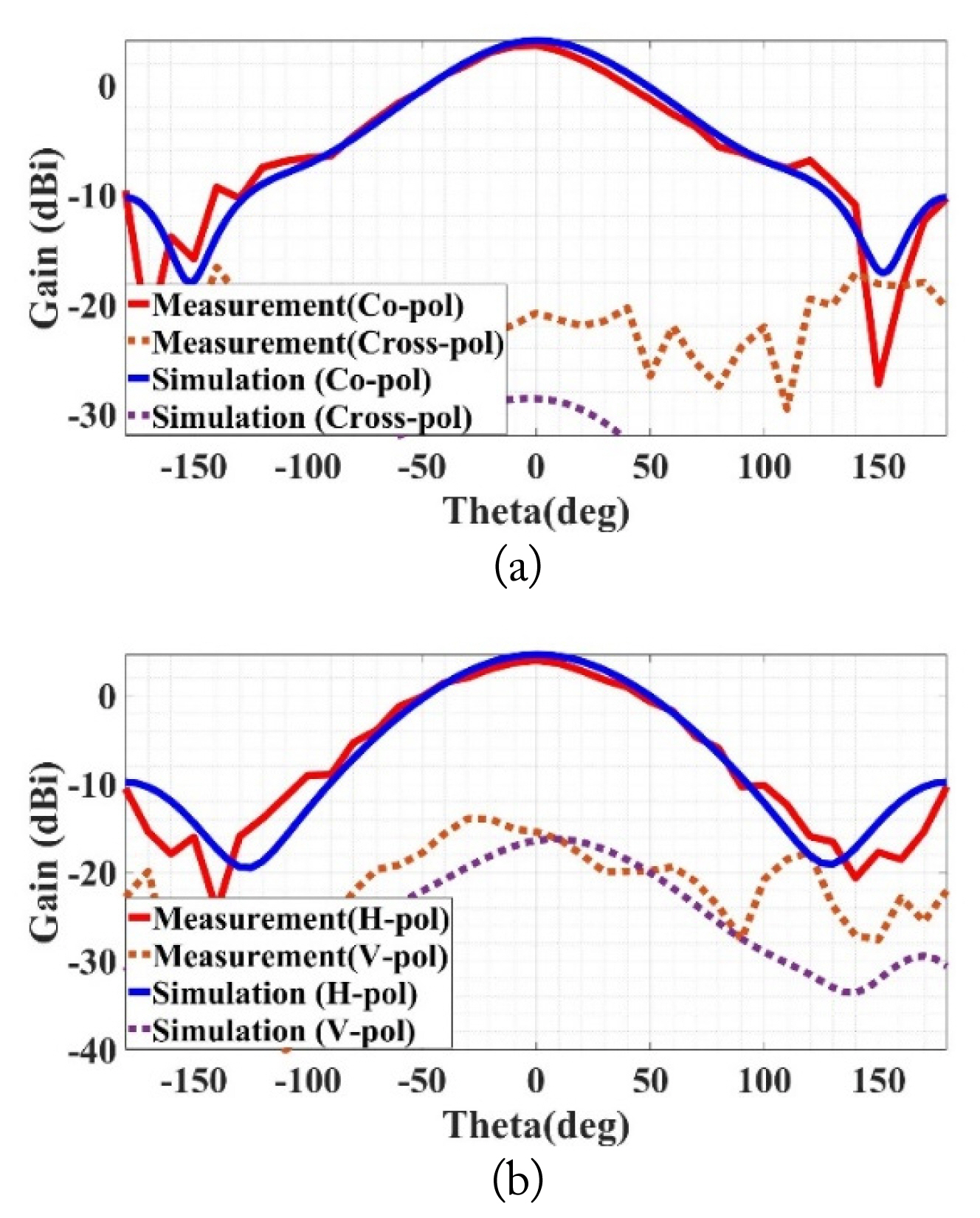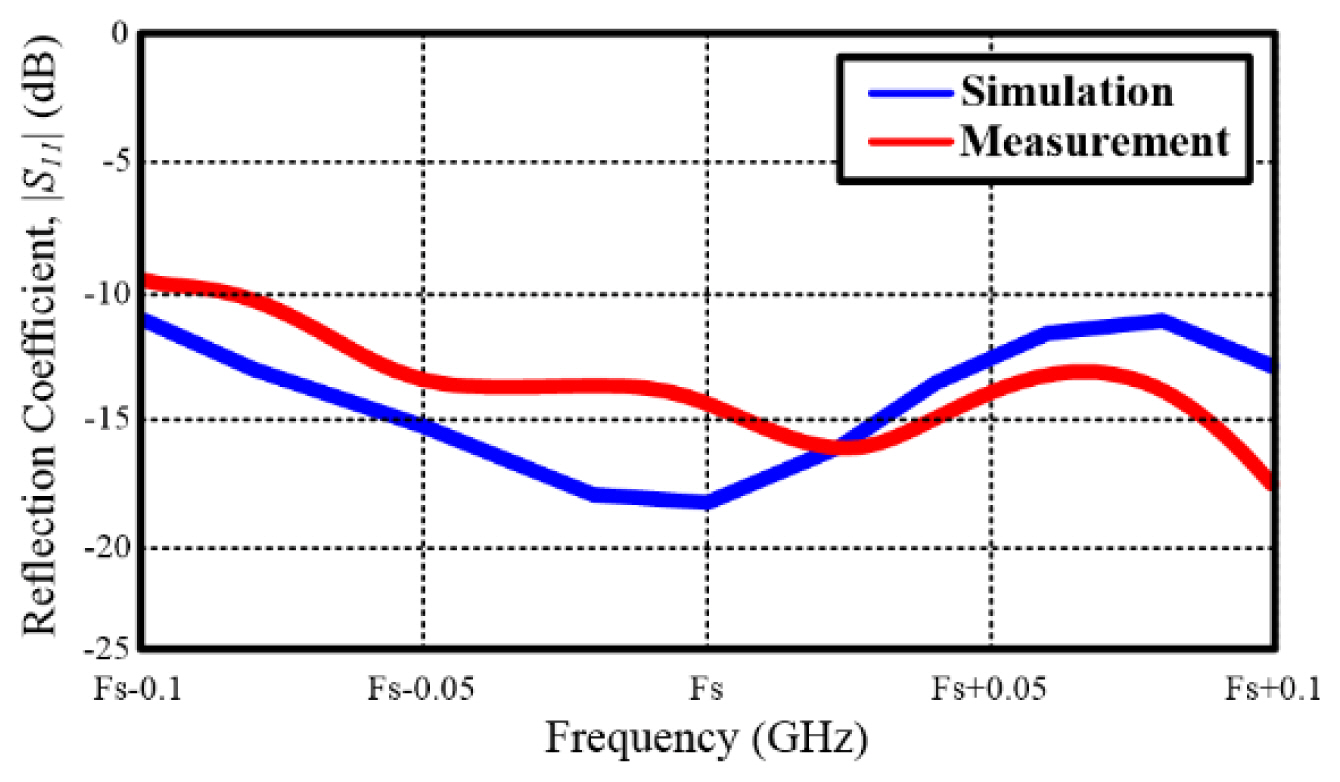 |
 |
- Search
| J. Electromagn. Eng. Sci > Volume 23(6); 2023 > Article |
|
Abstract
In this paper, a miniaturized multifunctional unit cell structure of a transmitarray operating at S-band and its verification method using a waveguide structure is presented. The unit cell of a multifunctional transmitarray antenna is a critical component because it controls the phase and polarization of an incident wave. The proposed unit cell consists of three main parts: an Rx antenna, a Tx antenna, and a control circuit for phase and polarization. The performance of the designed unit cell is verified by a rectangular waveguide structure. The waveguide structure feeds an electromagnetic wave propagating in a TE10 mode to a 1 ├Ś 2 unit cell array to verify polarization and phase shifting capability of the unit cell. The phase shifting and polarization conversion capabilities of the proposed unit cell are directly measured by the radiation patterns and polarization of the transmitted wave.
Beam steering array antennas are used in a variety of applications, such as radar and wireless communication, etc., because of their novel agile beam control capability [1, 2]. Numerous research efforts have reported beam steering methods and antenna structures to control radiation patterns and polarization [3ŌĆō7]. However, conventional active phased array antennas are widely adopted for beam steering antenna applications, but they require complex feeding networks, high-power consumption, and high-cost transceiver (TRx) systems [8, 9]. Recently, transmitarray and reflectarray antennas have become the focus of significant research owing to their low cost, low power consumption, and low system complexity compared to the conventional active phased array. For this reason, studies related to transmitarrays and reflectarrays have been reported [10ŌĆō13]. There are two main types of transmitarray antenna design. One type is a transmitarray composed of receive (Rx) and transmit (Tx) antennas, along with a phase shifter. Reconfigurable RF circuits, such as phase shifters and RF switches, achieve beam steering and polarization conversion [14ŌĆō17]. The other type is a transmitarray using a frequency selective surface (FSS) [18, 19]. In this case, multi-layer FSS using PIN diodes [20] and varactors [21] are adopted because it is challenging for a single-layer FSS to achieve a relative phase shift of 360┬░. Compared with the multilayer FSS-based transmitarray the RF circuit-based transmitarray type features a relatively low profile and a greater degree-of-freedom for beam forming and polarization conversion.
Similar to metasurface and FSS structures, a transmitarray is composed of an array of unit cells that can manipulate the phase or polarization of incident waves. The overall performance of a multifunctional transmitarray is heavily dependent on the individual unit cell performance. Therefore, unit cell verification plays a crucial role in debugging errors and inferring overall transmitarray or metasurface performance. By employing a rigorous unit cell verification method, the design effort and time required for a large transmitarray or metasurface design can be significantly reduced. Thus, unit cell functionality verification is one of the most critical design steps for mitigating potential risks when designing a full multifunctional transmitarray.
Recent studies have reported unit cell verification using the transition of two waveguides, confirming the characteristics of the unit cell with S-parameters inside the waveguide [22, 23]. However, this verification has some limitations because it verifies the unit cell inside the closed space of the waveguide. In the case of polarization conversion verification, it is necessary to convert the dominant mode of the waveguide according to the polarization conversion. However, it is difficult to reliably convert the dominant modes in conventional rectangular waveguide structures. Since the unit cell is verified using the S-parameter, the unit cell is limited to confirming the far-field and real-time beam steering characteristics of the transmitarray antenna. For this reason, there is a need for novel methods that verify unit cells in transmitarrays and surpass the limitations of previous approaches.
The present study proposes a unit cell verification method using a simple TE10 mode rectangular waveguide feeding network. The unit cell performance, such as beam steering and polarization selection, was verified and analyzed using the proposed unit cell verification method. Further, based on the unit cell verification, the performance of the reported 8 ├Ś 8 transmitarray antenna was compared [24]. The remainder of the paper is organized as follows. In Section II, the components and measurements of the unit cells are presented and discussed. The unit cell verification method and its operation principle are described in Section III. Section IV presents the conclusions drawn from the findings.
Fig. 1 shows the unit cell of the proposed transmitarray antenna for polarization conversions and beam steering operations in the S-band. The unit cell consists of three parts: the Rx antenna, Tx antenna, and control circuits, including a phase shifter and an SPDT PIN diode switch. The Rx antenna and circuit components were placed in the same plane, and the Tx antenna was placed on the opposite side. The incident wave was received by the Rx antenna, and the phase and polarization of the Rx wave were modulated by the RF circuit parts. The modulated wave was re-radiated by the Tx antenna. To avoid grating lobe and scan blinds, the size of the unit cell was limited to 0.4╬╗0 ├Ś 0.4╬╗0, which is a smaller unit cell period than the period of conventional transmitarray designs (0.5╬╗0 ├Ś 0.5╬╗0) [8]. The proposed unit cell architecture featured a planar low-profile structure and was fabricated using conventional low-cost, well-developed FR4 PCB technology (╔ør = 4.4, tan ╬┤ = 0.023). As shown in Fig. 1(d), the circuit layer and the Tx antenna feeding layer were attached using a bonding film, and the antennas (Rx and Tx) were fixed to this attachment layer with nylon bolts and nuts.
The Rx and Tx antennas were mounted at the bottom and top of the unit cell. The antenna performance of a transmitarray unit cell is critical because these antennas directly receive and reradiate the signal from a source antenna. Therefore, the antenna should have a high gain and a proper radiation pattern. In this work, both Rx and Tx antennas were designed as stacked patches, considering the limited size of the unit cell (0.4╬╗0 ├Ś 0.4╬╗0). Fig. 2 shows the geometries of the proposed Rx and Tx antennas. The antennas had improved bandwidth due to a three-layer of stacked patches and proximity coupled feeding [25, 26]. When an antenna is designed on a high-loss substrate, its radiation efficiency declines due to interactions with the loss of substrate. This reduction directly affects the overall performance of transmitarrays. To address this issue, the implementation of a three-layer patch results in a more centralized electric field for the antenna compared to a conventional patch antenna, thus improving antenna directivity. It reduces the interaction between the field and the high-loss FR4. As a result, the loss of the antenna is minimized, leading to an increase in gain.
The current distribution of the Tx and Rx antennas is illustrated in Fig. 3. Although the Rx and Tx antennas have similar stacked patch structures, there is a significant difference in antenna polarization. The Rx antenna is designed for single linear polarization, whereas the Tx antenna supports dual-linear polarization for polarization selection. As a result of this difference, the Tx antenna features two orthogonal distributions, while the Rx antenna has a single distribution. These surface current distributions provide insights into the resonance mode of Tx (TM10, TM01) and Rx (TM10) antenna. Fig. 4 shows the S-parameters and the fabricated Rx and Tx antennas. Each antenna was measured in an anechoic chamber, as shown in the inset of Fig. 4. The ŌłÆ10 dB impedance bandwidth of each antenna was sufficiently broad to cover the design target of Fs ┬▒ 0.05 GHz. The measured port isolation level between H-pol and V-pol was higher than 20 dB. Both the Rx and Tx antennas had broadside radiation patterns, as shown in Fig. 5. The co-pol and cross-pol gain values of the Rx antenna were measured to be 3.8 dBi and ŌłÆ21 dBi, respectively, at the operation frequency. The measured co-pol and cross-pol gain values of the Tx antenna were 4.25 dBi and ŌłÆ18 dBi, respectively, at the operation frequency. Certain discrepancies were observed between the simulation and measurements, as depicted in Figs. 4 and 5. During the fabrication process of the Rx and Tx antennas, three radiation layers were interconnected using bolts and nuts, which was challenging to precisely assemble by hand. As a result, small gaps occur between the layers, leading to subtle differences. However, despite these discrepancies, the simulations and measurements exhibited good agreement. Consequently, based on the aforementioned results, we confirmed that the antennas worked well as a Tx/Rx antenna.
At the bottom of the unit cell, as depicted in Fig. 1(c), there was an Rx antenna along with the control circuit. The control circuit comprised two main components: the phase shifter and the SPDT switch. Given the smaller size of the unit cell, careful consideration is required for the design of the phase shifter. To address this, this paper presents a miniaturized reflection-type phase shifter, as illustrated in Fig. 6(a). The proposed phase shifter consists of inductively loaded transmission lines for system miniaturization and two reflection loads for a broad phase-shift range of 0┬░ŌĆō345┬░ [27]. Two varactors were connected in series, and a 90┬░ transmission line was resonated at the target frequency to improve the phase-shift range, as shown in Fig. 6(b). The varactor (MACOM MA46H120 [28]) was controlled by a DC bias voltage of 0ŌĆō10 V. The reflection coefficient of the load is shown in Eqs. (1) and (2) [27]:
where Zo is 50 ╬® and XL is equal to ŽēLs ŌĆō 1/ŽēCv. The high-frequency current entering the bias line was blocked by the RF choke, and the DC current was blocked by the DC block. A conventional reflection-type reflector using a branch line coupler was miniaturized by an inductively loaded microstrip transmission line to integrate it with an Rx antenna in the same plane [29]. The designed miniaturized full-range reflection-type phase shifter was 36% smaller than a conventional reflection-type phase shifter. Fig. 6(c) shows the measured relative phase shift in degrees and the insertion loss (IL) of the proposed phase shifter. As the bias voltage changed from 0ŌĆō10 V, the corresponding relative phase shift range varied between 0┬░ŌĆō345┬░. In addition, the measured IL varied between 1.8 and 5.5 dB, depending on the voltage change. The IL variations were a result of the resonant properties of the series-connected varactors and the quarterwavelength T-line.
For polarization selection, the phase-shifted signal was directed to the V- or H-pol ports of the Tx antenna using an SPDT PIN diode switch, as shown in Fig. 7(a). The SPDT switch consisted of two PIN diodes (MACOM MA4AGP907 [30]), which were turned on and off exclusively. For example, 1.35 V and ŌłÆ5 V were applied to P3 and P2, respectively, to direct the input signal to P2. Fig. 7(b) shows the measured S-parameters of the designed SPDT switch. In this case, VV = ŌłÆ5 V and VT = 1.35 V (D1: on, D2: off). The measured IL of the switch from 0ŌĆō20 dBm input power was approximately 0.7 dB, and the isolation level was approximately 27 dB. We experimentally verified that the proposed SPDT RF PIN diode switch satisfied all the design requirements for polarization selection, such as low loss, power-handling capability, and high isolation.
The geometry of the proposed network and its measurement setup are shown in Fig. 8. A specially fabricated waveguide is employed for unit cell verification, allowing for a seamless connection between the unit cell and the standard WR284 waveguide. The 1 ├Ś 2 unit cell array was chosen as the verification test board because it is the smallest array size for verify beam steering. The minimum dimensions of the 1 ├Ś 2 unit cell array were 80 mm in length and 40 mm in width. However, an additional 40 mm in length and 10 mm in width were included. This is because placing the 1 ├Ś 2 Rx antenna array in the center of the rectangular waveguide required an additional length of 40 mm. An extra 10-mm width was required for mechanical stability. It is important to align the 1 ├Ś 2 unit cell array to the center of the waveguide aperture because the E-field of the incident TE10 wave is applied to the 1 ├Ś 2 Rx patch antenna array symmetrically with the same polarization as the antenna.
This section describes the operation principle of the proposed unit cell verification method using a TE10 mode rectangular waveguide. In general, multifunctional unit cells are required to simultaneously control the polarization and phase of the incident wave [31]. The proposed waveguide-fed unit cell verification method confirmed the efficiency of the unit cell, polarization conversion, and phase shift. The efficiency of the unit cell (╬Ęcell) is the ratio of the accepted power (Pa) by unit cells ((1-|╬ō|2)┬ĘPin) to the total radiated power (Pr), where Pin is the input power and ╬ō is the reflection coefficient. Thus, the efficiency of the unit cell was calculated as ╬Ęcell = Pr/[(1-|╬ō|2)┬ĘPin]. The calculated unit cell efficiency was approximately 13.2% because the loss values of the Tx/Rx antenna, switch (SW), and phase shifter (0 V) at Fs GHz were about 2.5 dB, 0.7 dB, and 3.1 dB, respectively. The polarization conversion and phase-shifting capability were easily measured by observing far-field patterns. Whereas the polarization conversion was easy to measure, the measurement of the unit cellŌĆÖs phase-shifting performance was challenging. The phase-shift performance was measured indirectly by observing the radiation patterns of a waveguide-fed 1 ├Ś 2 unit cell array.
A shunt inductive iris was connected in parallel to match the 1 ├Ś 2 unit cell array to the designed 120 mm ├Ś 50 mm rectangular waveguide. A linear waveguide taper was designed to match the standard WR284 coax-to-waveguide transition to the designed rectangular waveguide. In this work, linear taper and rectangular waveguide structures were made of aluminum. The linear waveguide taper shown in Fig. 8(a) was designed to transfer a dominant TE10 mode wave from the standard WR-284 to the designed 120 mm ├Ś 50 mm rectangular waveguide while suppressing mode conversion and higher-order mode excitation [32, 33]. The linear tapered matching waveguide section was designed for TE10 single-mode operation using coupled-mode theory. The coupled-mode theory based on a cross-sectional method is a powerful design procedure for waveguide matching networks; thus, the total E- and H-fields along a general non-uniform waveguide structure can be calculated [34ŌĆō36]. When a given waveguide structure operates in a single mode, the complex amplitude of forward (a+) and backward (aŌłÆ) traveling waves associated with the propagation modes can be determined by a simple coupled-mode equation system, which is a strong function of the coupling coefficient (K) between those waves [35]. The K value of a rectangular waveguide for TE10 single-mode operation having a propagation constant of ╬▓10 was calculated analytically, as shown in Eq. (3) [37].
where a(z) and b(z) are the width and height along the z-direction, respectively. Eq. (3) clearly shows that the rate of change in the width or height profile along the wave propagation direction is an important design factor for the waveguide taper design. In this study, a single-mode rectangular waveguide taper with simultaneous variations in height and width was designed to match the 120 mm ├Ś 50 mm rectangular waveguide to the WR-284 standard. An inherent port mismatch level (Žü0), which is a function of the difference between the cross-sections, was set to a value less than ŌłÆ15 dB (Žü0 < ŌłÆ15 dB). The length of the linear waveguide taper was 50 mm, as shown in Fig. 8. The designed 120 mm ├Ś 50 mm rectangular waveguide had three available propagation modes of TE10, TE20, and TE01 around the operation frequency (Fs), but the mode conversion level (TE10-to-TE20, and TE10-to-TE01) was less than ŌłÆ31 dB.
The fabricated waveguide-based feeding structure for the 1 ├Ś 2 unit cell array was 50 mm ├Ś 120 mm ├Ś 100 mm, as shown in Fig. 8(c). The designed rectangular waveguide structure was compatible with the WR-284 standard. A shunt inductive iris matched the 1 ├Ś 2 unit cell array to the coax-to-WR-284 waveguide transition. The measured reflection coefficient (|S11|) of the designed rectangular waveguide-fed 1 ├Ś 2 unit cell array is shown in Fig. 9. We observed a discrepancy between the measurements and simulations, which can be attributed to fabrication errors in the customized waveguide. However, despite this discrepancy, both the measured and simulated data exhibited a similarity below ŌłÆ10 dB at the operating frequency, suggesting tight coupling between the Rx antennas and the waveguide. The rectangular waveguide-fed 1 ├Ś 2 array was measured in the anechoic chamber like Tx/Rx antennas, and the measured ╬Ęcell was 14.7% (ŌłÆ8.4 dB) with an input power of 30 dBm (Pin = 1 W). This was calculated by taking the ratio of the total radiated power to the power delivered to the array, as discussed in Section III-1. The measured total radiated and delivered power were 142.0 mW and 968.4 mW, respectively. This was very close to the theoretical efficiency of 13.2% of the unit cell discussed in Section III-1. As previously mentioned, the input power was tightly coupled and delivered to the unit cell without being reflected. Therefore, the measured efficiency can be regarded as the element loss (EL) of the full transmitarray antenna. The loss of the transmitarray antenna (╬Ąloss) is calculated as shown in Eq. (4) [31]:
where ╬Ęspill and ELavg are spillover efficiency and element loss, respectively. ╬Ęspill is the ratio of accepted power to total power radiated by the feed, and it was calculated to be ŌłÆ2.3 dB using Ansys High-Frequency Structure Simulator (HFSS). The proposed verification was compared with the losses per component, as shown in Table 1. The total transmitarray loss (╬Ąloss) of the simulation was ŌłÆ11.1 dB, and the proposed method was ŌłÆ10.7 dB. The measured ╬Ąloss values of a fabricated 8 ├Ś 8 transmitarray antenna composed of the presented unit cell were ŌłÆ10.75 dB [24]. A comparison of the measured ╬Ąloss with the simulated losses showed good agreement, but the loss of the proposed method (ŌłÆ10.7 dB) more strictly predicts the measured value (ŌłÆ10.75 dB). Therefore, the proposed verification method provides useful information on the design and optimization of a full-sized multifunctional transmitarray or metasurface.
The simulation setup for unit cell verification is depicted in Fig. 10(a) and performed using HFSS. The standard WR-284 waveguide, excited by the waveport of a coaxial cable, was included in the model. A customized waveguide was positioned between the 2 ├Ś 1 array and the modeled WR-284, and the entire model, enclosed within a radiation box, was simulated. Fig. 10(b) and 10(c) show the radiation patterns of the waveguide- fed 1 ├Ś 2 array when there were no phase differences between the unit cells. The simulation and measurement data agreed very well. The polarization conversion capability was clearly observed, and the measured cross-pol suppression levels for both the V-to-V-pol and V-to-H-pol conversion cases were about 15 dB. The rectangular GND (ground) shapes had a difference between Fig. 10(a) and 10(b) because the GND lengths of the Tx antennas for V-pol and H-pol were asymmetric. Fig. 11 shows the measured beam steering capability for V-to-V and V-to-H polarization conversions. The ┬▒ 25┬░ beam steering was achieved when the bias voltage for the phase shifter was 1.9 V, corresponding to a 90┬░ phase shift. These results show that the proposed unit cell verification method successfully characterized all electrical properties, such as polarization conversion, phase shifting, and efficiency of a unit cell or a full-sized multifunctional transmitarray.
Table 2 displays a performance comparison between the proposed unit cell and the literature-reported transmitarray antennas. The results show that our proposed unit cell features a smaller size and higher phase resolution compared to other literature-reported transmitarrays. This confirms the superior performance of our proposed unit cell in terms of size reduction and phase control. In addition, conventional verification using a double waveguide structure and the proposed verification were compared, as shown in Table 3. Notably, all electrical properties of a multifunctional unit cell, such as unit cell loss, polarization conversion, relative phase shift, and far-field radiation patterns, can be experimentally verified through a one-time measurement. It is also possible to measure cross-pol suppressing levels. The rectangular waveguide structure of conventional verification methods supports only a single dominant mode at the operating frequency. The conventional closed waveguide structure for unit cell verification has limitations in measuring polarization conversion capability.
This paper presents the structure of a unit cell for a multifunctional transmitarray and its verification method using a rectangular waveguide structure. The unit cell can simultaneously manipulate the phase and polarization of incident waves. The functionality of the designed unit cell was verified by using a 2 ├Ś 1 unit cell array fed by a rectangular waveguide structure. The 2 ├Ś 1 unit cell array was fed by a TE10 mode wave whose polarization was matched to the Rx antennas. The performance of a unit cell, such as phase shifting and polarization conversion capabilities, was measured and verified using the proposed method. The proposed verification method is a promising candidate that can be used as a unit cell verification for multifunctional transmitarrays with polarization conversion and beam steering functions.
Acknowledgments
This work was supported by Hanwha Systems, funded by the Future Challenge Technology Program of the Agency for Defense Development.
Fig.┬Ā1
Proposed unit cell structure for multifunctional transmitarray: (a) system block diagram, (b) 3D structure, (c) bottom view, and (d) side view.
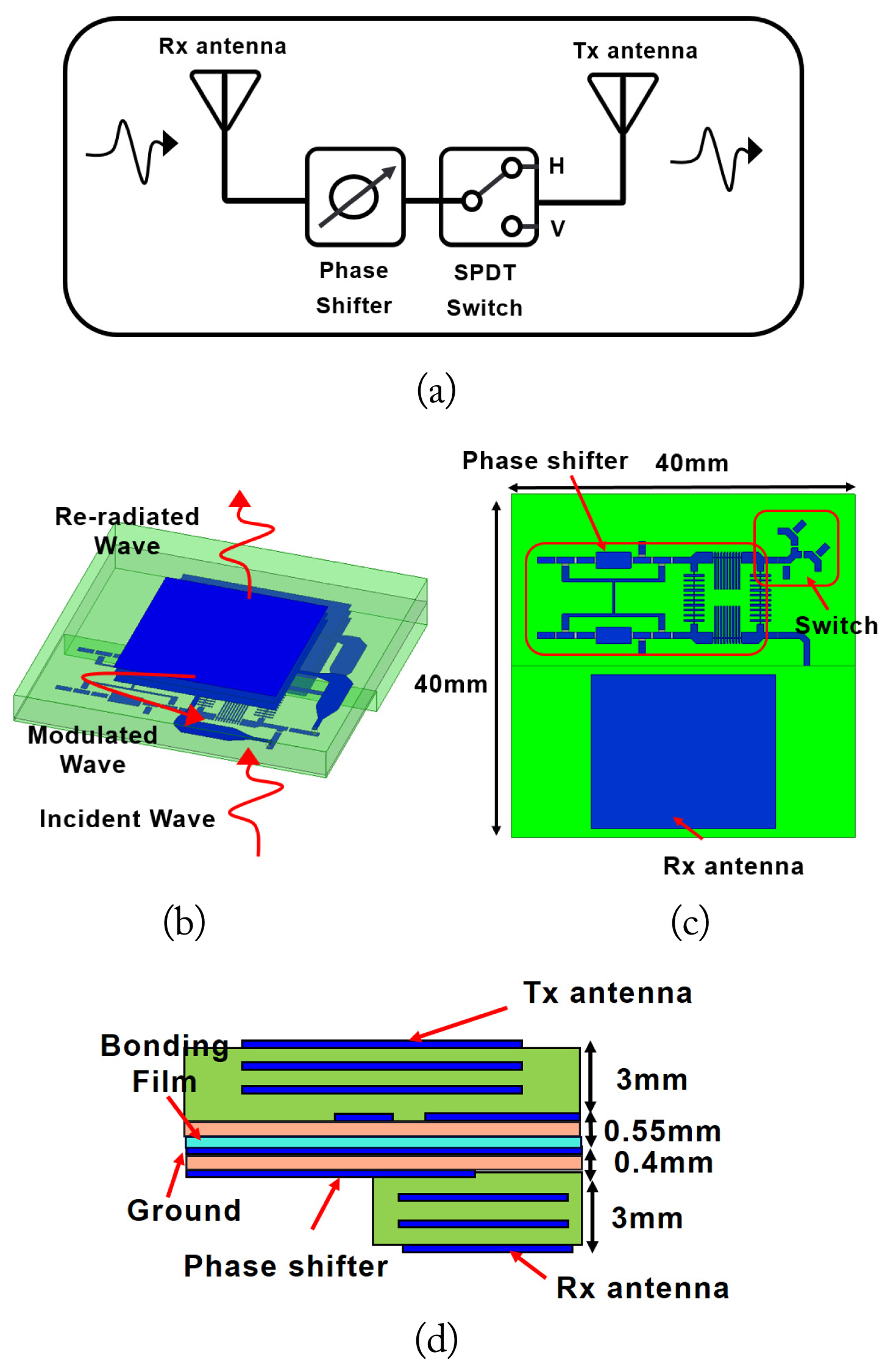
Fig.┬Ā3
Surface current distributions: Rx and Tx antennas corresponding to the polarization at the operating frequency.
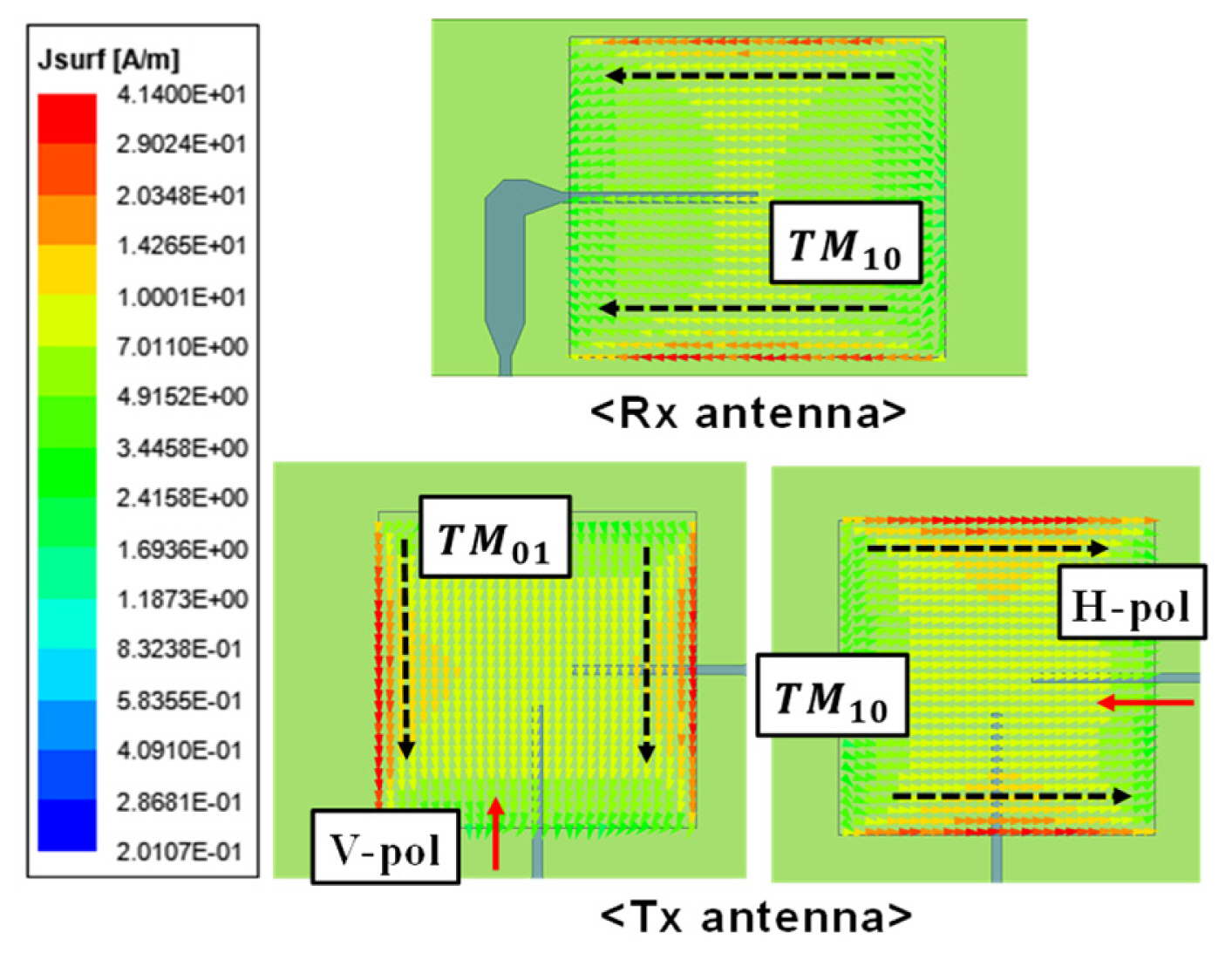
Fig.┬Ā6
(a) Structure and (b) reflection load of the miniaturized phase shifter, and (c) measured phase shifting range and insertion loss.
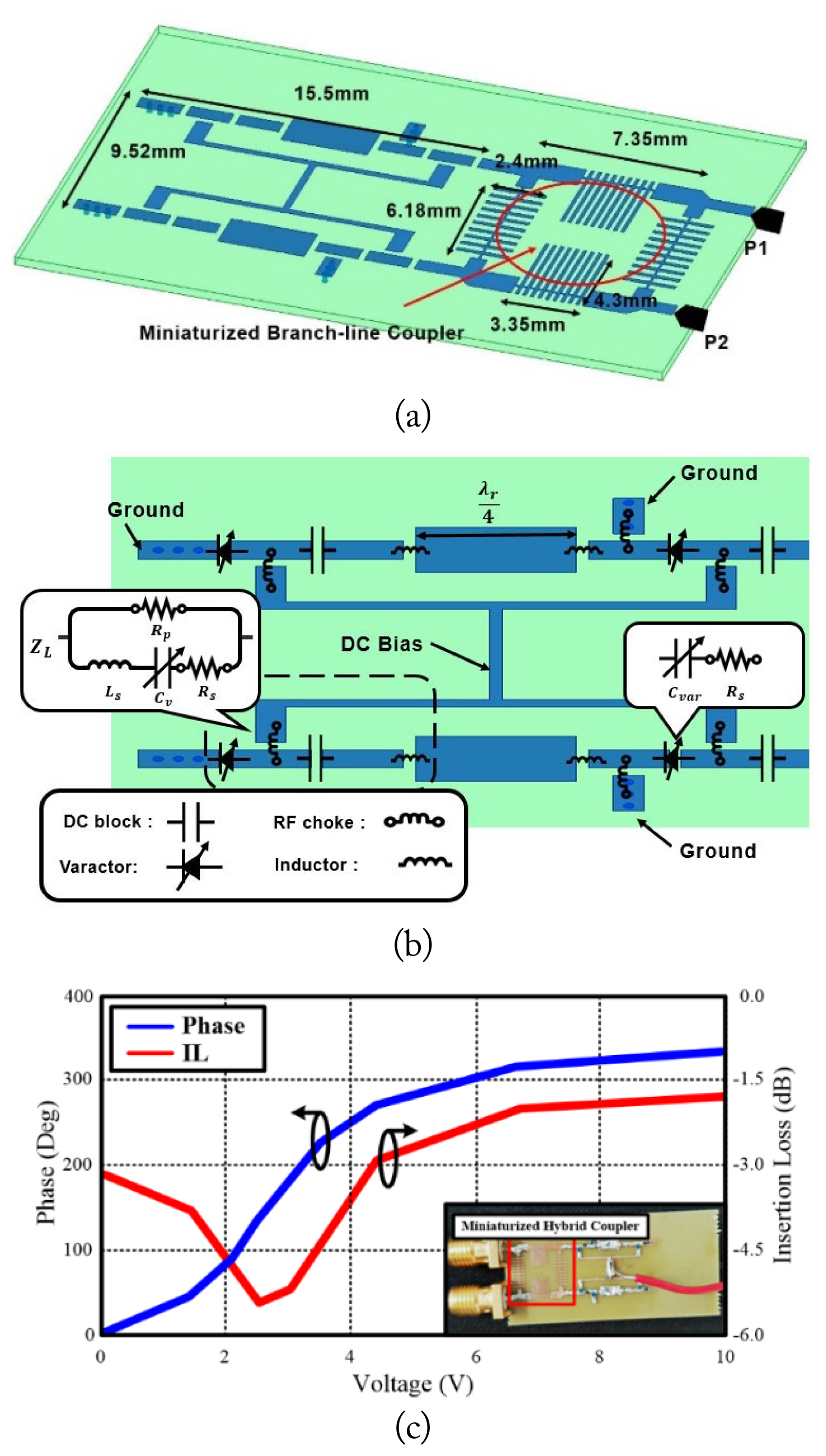
Fig.┬Ā8
Geometry of the proposed unit cell verification method: (a) top view, (b) side view, and (c) measurement setup in the anechoic chamber.
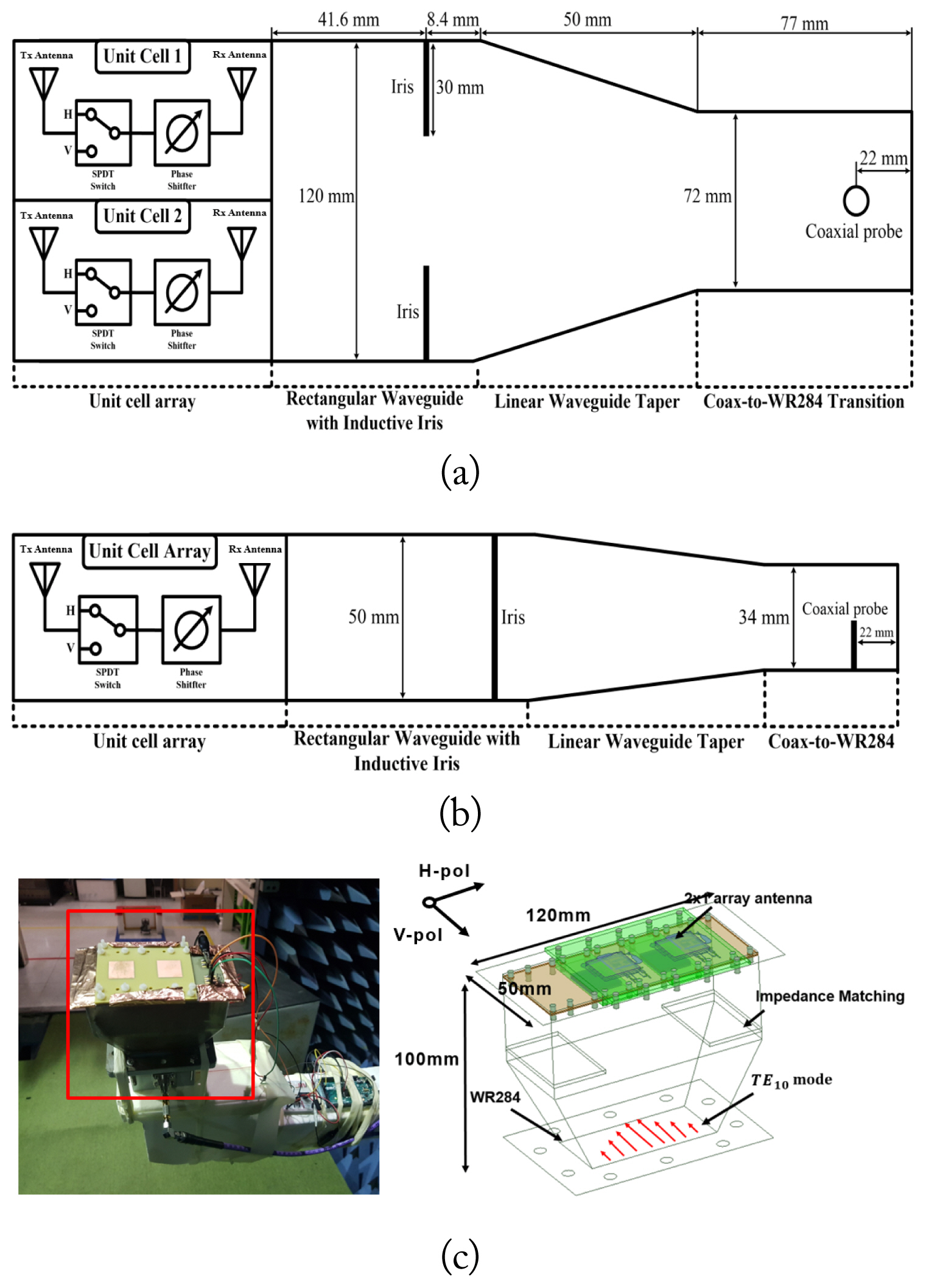
Fig.┬Ā10
(a) Unit cell verification simulation (Ansys High Frequency Structure Simulation, HFSS) and (b) VŌåÆH and (c) VŌåÆV polarization conversion at the operation frequency.
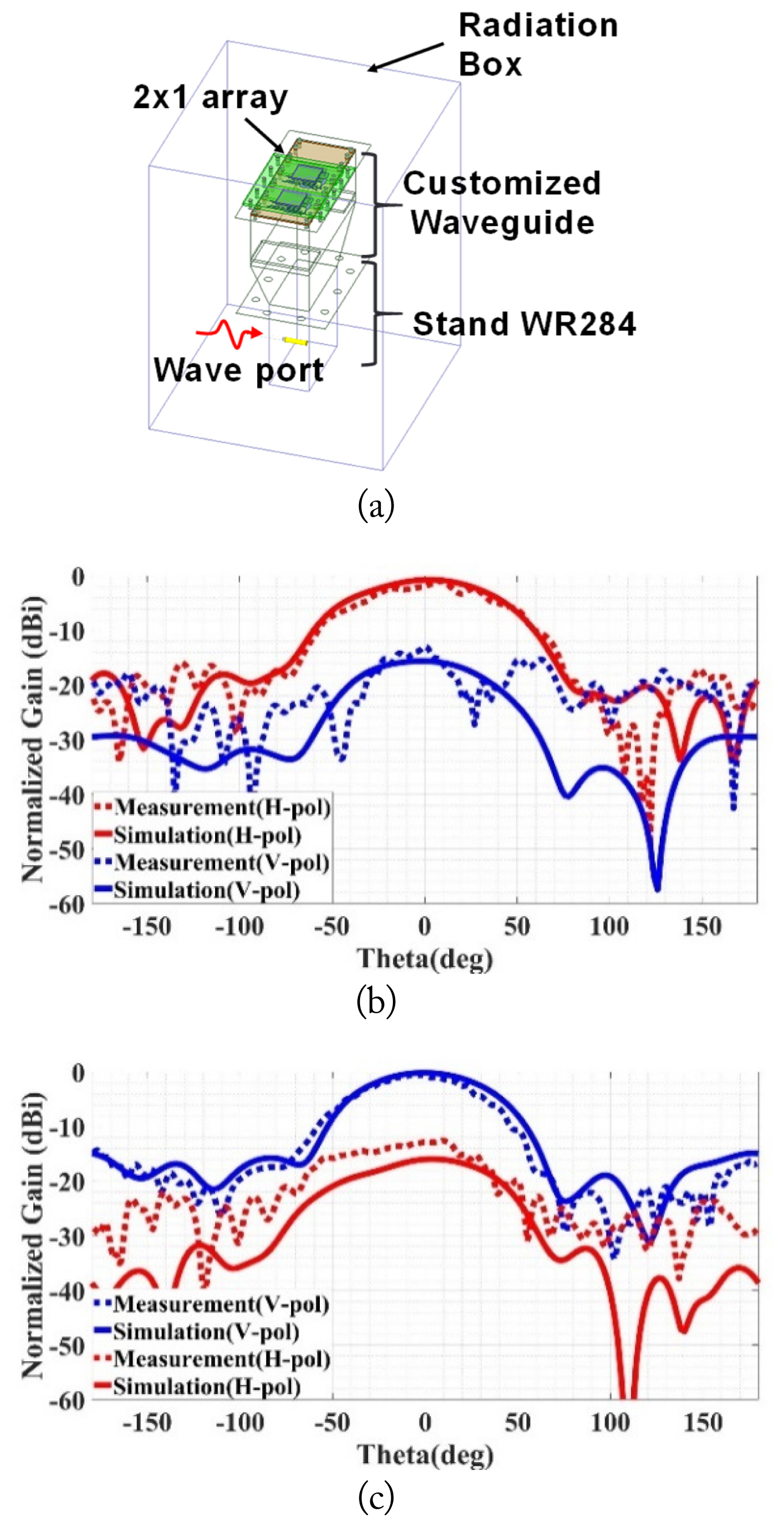
Table┬Ā1
Efficiency analysis
Table┬Ā2
Performance comparison between the proposed unit cell and literature-reported transmitarray antennas
| Study | Freq. band | Unit cell size | Phase shifting | Polarization conversion |
|---|---|---|---|---|
| Zhou et al. [10] | C | 0.48╬╗0├Ś0.48╬╗0 | 0ŌĆō360┬░ (analog) | LPŌåÆLP/CP |
| Wang et al. [11] | C | 0.49╬╗0├Ś0.49╬╗0 | 1 bit + 0ŌĆō180┬░ (hybrid) | LPŌåÆCP |
| Wang et al. [12] | X | 0.47╬╗0├Ś0.47╬╗0 | 1bit (digital) | LPŌåÆLP |
| Zhang et al. [13] | C | 0.49╬╗0├Ś0.49╬╗0 | 1 bit + 0ŌĆō180┬░ (hybrid) | No |
| Sofi et al. [18] | X | 0.52╬╗0├Ś0.52╬╗0 | 1 bit (digital) | LPŌåÆLP |
| Abdollahvand et al. [19] | X | 0.54╬╗0├Ś0.54╬╗0 | 1 bit (digital) | No |
| This work | S | 0.4╬╗0├Ś0.4╬╗0 | 0ŌĆō330┬░ (analog) | LPŌåÆLP |
References
1. S. Kutty and D. Sen, "Beamforming for millimeter wave communications: an inclusive survey," IEEE Communications Surveys & Tutorials, vol. 18, no. 2, pp. 949ŌĆō973, 2016. https://doi.org/10.1109/COMST.2015.2504600

2. W. D. Wirth, Radar Techniques Using Array Antennas. London, UK: Institute of Engineering and Technology, 2001.
3. J. R. Reis, M. Vala, and R. F. Caldeirinha, "Review paper on transmitarray antennas," IEEE Access, vol. 7, pp. 94171ŌĆō94188, 2019. https://doi.org/10.1109/ACCESS.2019.2924293

4. P. Nayeri, F. Yang, and A. Z. Elsherbeni, "Beam-scanning reflectarray antennas: a technical overview and state of the art," IEEE Antennas and Propagation Magazine, vol. 57, no. 4, pp. 32ŌĆō47, 2015. https://doi.org/10.1109/MAP.2015.2453883

5. M. Nikfalazar, M. Sazegar, A. Mehmood, A. Wiens, A. Friederich, H. Maune, J. R. Binder, and R. Jakoby, "Two-dimensional beam-steering phased-array antenna with compact tunable phase shifter based on BST thick films," IEEE Antennas and Wireless Propagation Letters, vol. 16, pp. 585ŌĆō588, 2016. https://doi.org/10.1109/LAWP.2016.2591078

6. B. Yu, K. Yang, and G. Yang, "A novel 28 GHz beam steering array for 5G mobile device with metallic casing application," IEEE Transactions on Antennas and Propagation, vol. 66, no. 1, pp. 462ŌĆō466, 2018. https://doi.org/10.1109/TAP.2017.2772084

7. E. Topak, J. Hasch, C. Wagner, and T. Zwick, "A novel millimeter-wave dual-fed phased array for beam steering," IEEE Transactions on Microwave Theory and Techniques, vol. 61, no. 8, pp. 3140ŌĆō3147, 2013. https://doi.org/10.1109/TMTT.2013.2267935

8. R. J. Mailloux, Phased Array Antenna Handbook. Norwood, MA: Artech House, 1993.
9. J. C. S. Chieh, E. Yeo, R. Farkouh, A. Castro, M. Kerber, R. B. Olsen, E. J. Merulla, and S. K. Sharma, "Development of flat panel active phased array antennas using 5G silicon RFICs at Ku-and Ka-bands," IEEE Access, vol. 8, pp. 192669ŌĆō192681, 2020. https://doi.org/10.1109/ACCESS.2020.3032841

10. E. Zhou, Y. Cheng, F. Chen, and H. Luo, "Wideband and high-gain patch antenna with reflective focusing metasurface," AEU-International Journal of Electronics and Communications, vol. 134, article no. 153709, 2021. https://doi.org/10.1016/j.aeue.2021.153709

11. J. Wang, Y. Cheng, H. Luo, F. Chen, and L. Wu, "High-gain bidirectional radiative circularly polarized antenna based on focusing metasurface," AEU-International Journal of Electronics and Communications, vol. 151, article no. 154222, 2022. https://doi.org/10.1016/j.aeue.2022.154222

12. J. Wang, J. Zhao, Y. Cheng, H. Luo, and F. Chen, "Dual-band high-gain microstrip antenna with a reflective focusing metasurface for linear and circular polarizations," AEU-International Journal of Electronics and Communications, vol. 157, article no. 154413, 2022. https://doi.org/10.1016/j.aeue.2022.154413

13. Z. Zhang, Y. Cheng, H. Luo, and F. Chen, "Low-profile wideband circular polarization metasurface antenna with characteristic mode analysis and mode suppression," IEEE Antennas and Wireless Propagation Letters, vol. 22, no. 4, pp. 898ŌĆō902, 2023. https://doi.org/10.1109/LAWP.2022.3227881

14. C. Huang, W. Pan, X. Ma, B. Zhao, J. Cui, and X. Luo, "Using reconfigurable transmitarray to achieve beam-steering and polarization manipulation applications," IEEE Transactions on Antennas and Propagation, vol. 63, no. 11, pp. 4801ŌĆō4810, 2015. https://doi.org/10.1109/TAP.2015.2479648

15. C. Huang, W. Pan, and X. Luo, "Low-loss circularly polarized transmitarray for beam steering application," IEEE Transactions on Antennas and Propagation, vol. 64, no. 10, pp. 4471ŌĆō4476, 2016. https://doi.org/10.1109/TAP.2016.2586580

16. B. Rana, I. G. Lee, and I. P. Hong, "Digitally reconfigurable transmitarray with beam-steering and polarization switching capabilities," IEEE Access, vol. 9, pp. 144140ŌĆō144148, 2021. https://doi.org/10.1109/ACCESS.2021.3121990

17. J. Tang, S. Xu, F. Yang, and M. Li, "Design and measurement of a reconfigurable transmitarray antenna with compact varactor-based phase shifters," IEEE Antennas and Wireless Propagation Letters, vol. 20, no. 10, pp. 1998ŌĆō2002, 2021. https://doi.org/10.1109/LAWP.2021.3101891

18. M. A. Sofi, K. Saurav, and S. K. Koul, "Frequency-selective surface-based compact single substrate layer dual-band transmission-type linear-to-circular polarization converter," IEEE Transactions on Microwave Theory and Techniques, vol. 68, no. 10, pp. 4138ŌĆō4149, 2020. https://doi.org/10.1109/TMTT.2020.3002248

19. M. Abdollahvand, E. Martinez-de-Rioja, J. A. Encinar, K. Katoch, A. Ebrahimi, and S. Ghosh, "Reconfigurable FSS with a switchable passband for space applications in X and Ka bands," In: Proceedings of 2022 16th European Conference on Antennas and Propagation (EuCAP); Madrid, Spain. 2022, pp 1ŌĆō4. https://doi.org/10.23919/EuCAP53622.2022.9769497

20. A. Iturri-Hinojosa, J. I. Martinez-Lopez, and A. E. Martynyuk, "Analysis and design of E-plane scanning grid arrays," IEEE Transactions on Antennas and Propagation, vol. 58, no. 7, pp. 2266ŌĆō2274, 2010. https://doi.org/10.1109/TAP.2010.2048846

21. W. Pan, C. Huang, P. Chen, M. Pu, X. Ma, and X. Luo, "A beam steering horn antenna using active frequency selective surface," IEEE Transactions on Antennas and Propagation, vol. 61, no. 12, pp. 6218ŌĆō6223, 2013. https://doi.org/10.1109/TAP.2013.2280592

22. W. Pan, C. Huang, X. Ma, B. Jiang, and X. Luo, "A dual linearly polarized transmitarray element with 1-bit phase resolution in X-band," IEEE Antennas and Wireless Propagation Letters, vol. 14, pp. 167ŌĆō170, 2014. https://doi.org/10.1109/LAWP.2014.2358267

23. B. D. Nguyen and C. Pichot, "Unit-cell loaded with PIN diodes for 1-bit linearly polarized reconfigurable transmitarrays," IEEE Antennas and Wireless Propagation Letters, vol. 18, no. 1, pp. 98ŌĆō102, 2019. https://doi.org/10.1109/LAWP.2018.2881555

24. M. Hwang, G. Kim, J. Kim, and S. Kim, "A simultaneous beam steering and polarization converting S-band transmitarray antenna," IEEE Access, vol. 10, pp. 105111ŌĆō105119, 2022. https://doi.org/10.1109/ACCESS.2022.3211303

25. S. Egashira and E. Nishiyama, "Stacked microstrip antenna with wide bandwidth and high gain," IEEE Transactions on Antennas and Propagation, vol. 44, no. 11, pp. 1533ŌĆō1534, 1996. https://doi.org/10.1109/8.542079

26. W. S. Rowe and R. B. Waterhouse, "Investigation into the performance of proximity coupled stacked patches," IEEE Transactions on Antennas and Propagation, vol. 54, no. 6, pp. 1693ŌĆō1698, 2006. https://doi.org/10.1109/TAP.2006.875462

27. C. S. Lin, S. F. Chang, and W. C. Hsiao, "A full-336.75┬░ reflection-type phase shifter with constant insertion loss," IEEE Microwave and Wireless Components Letters, vol. 18, no. 2, pp. 106ŌĆō108, 2008. https://doi.org/10.1109/LMWC.2007.915094

28. MACOM, MA46H120: gallium arsenide flip chip hyper-abrupt varactor diode, c2023. [Online]. Available: https://www.macom.com/products/product-detail/MA46H120
29. K. O. Sun, S. J. Ho, C. C. Yen, and D. Van Der Weide, "A compact branch-line coupler using discontinuous microstrip lines," IEEE Microwave and Wireless Components Letters, vol. 15, no. 8, pp. 5202005. https://doi.org/10.1109/LMWC.2005.852789

30. MACOM, MA4AGP907: aluminum gallium arsenide (AlGaAs) flip chip PIN diode, c2023. [Online]. Available: https://www.macom.com/products/product-detail/MA4AGP907
31. A. H. Abdelrahman, F. Yang, A. Z. Elsherbeni, P. Nayeri, and C. A. Balanis, Analysis and Design of Transmitarray Antennas. Cham, Switzerland: Springer, 2017. https://doi.org/10.1007/978-3-031-01541-0
32. S. S. Saad, J. B. Davies, and O. J. Davies, "Computer analysis of gradually tapered waveguide with arbitrary cross sections (short papers)," IEEE Transactions on Microwave Theory and Techniques, vol. 25, no. 5, pp. 437ŌĆō440, 1977. https://doi.org/10.1109/TMTT.1977.1129120

33. C. C. H. Tang, "Mode conversion in tapered waveguides at and near cutoff," IEEE Transactions on Microwave Theory and Techniques, vol. 14, no. 5, pp. 233ŌĆō239, 1966. https://doi.org/10.1109/TMTT.1966.1126234

34. S. Lee, D. Son, J. Y. Kwon, and Y. B. Park, "Analysis of a tapered rectangular waveguide for V to W millimeter wavebands," Journal of Electromagnetic Engineering and Science, vol. 18, no. 4, pp. 248ŌĆō253, 2018. https://doi.org/10.26866/jees.2018.18.4.248

35. I. Arnedo, I. Arregui, M. Chudzik, F. Teberio, A. Lujambio, D. Benito, T. Lopetegi, and M. A. Laso, "Direct and exact synthesis: controlling the microwaves by means of synthesized passive components with smooth profiles," IEEE Microwave Magazine, vol. 16, no. 4, pp. 114ŌĆō128, 2015. https://doi.org/10.1109/MMM.2015.2394011

36. B. Z. Katsenelenbaum, L. Mercader del Rio, M. Pereyaslavets, M. Sorolla Ayza, and M. Thumm, Theory of Nonuniform Waveguides: The Cross-Section Method. Herts, UK: The Institute of Electrical Engineers, 1998.
37. J. M. Percaz, I. Arnedo, I. Arregui, F. Teberio, P. Mart├Łn-Iglesias, M. A. Laso, and T. Lopetegi, "General synthesis of tapered matching sections for single-mode operation using the coupled-mode theory," IEEE Transactions on Microwave Theory and Techniques, vol. 67, no. 9, pp. 3511ŌĆō3526, 2019. https://doi.org/10.1109/TMTT.2019.2929132

Biography
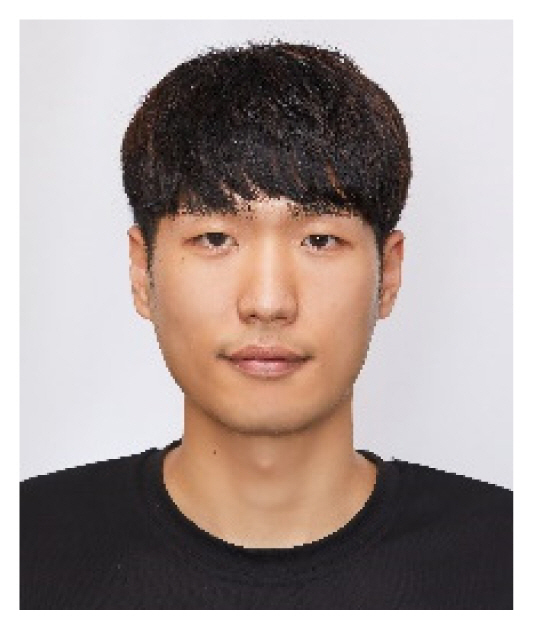
Gyoungdeuk Kim, https://orcid.org/0000-0003-2752-1087 received his B.S. degree in electronics engineering from Pusan National University, South Korea, in 2020, where he is currently pursuing his M.S. and Ph.D. degrees. His current research interests include antenna design and RF systems.
Biography

Myeongha Hwang, https://orcid.org/0000-0002-2517-9698 received his B.S. degree from the Department of Electronics Engineering, Pusan National University, Busan, Republic of Korea in 2020, where he is currently pursuing his M.S. and Ph.D. degrees. His current research interests include array antenna design and RF systems.
Biography
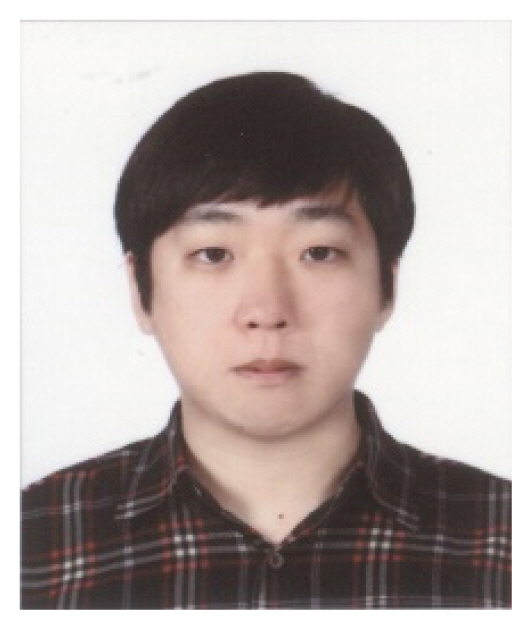
Ingon Lee, https://orcid.org/0000-0002-3974-4766 received his M.S. and Ph.D. degrees in information and communication engineering from Kongju National University, Cheonan, South Korea, in 2016 and 2020, respectively. From 2020 to 2021, he worked as a post-doc research fellow at the same university in South Korea. Since 2021, he has been working at Hanwha Systems, Yongin, South Korea, where he is currently a Senior Engineer. His research interests include periodic electromagnetic structures, microwave/millimeterwave circuits and components, and transmitarray antennas for radar applications.
Biography
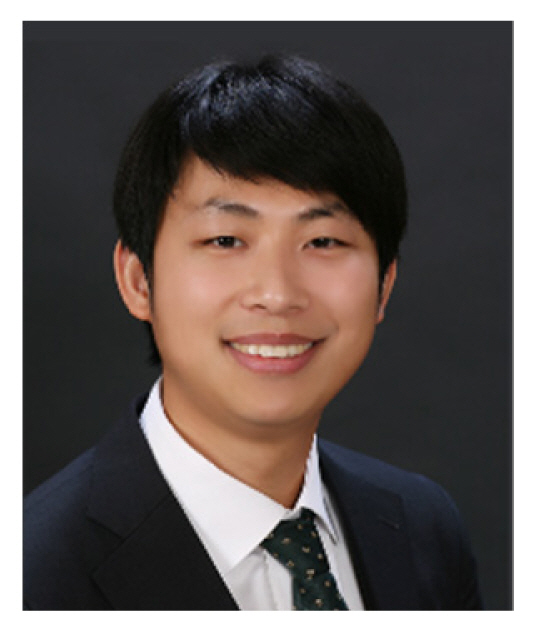
Sangkil Kim, https://orcid.org/0000-0003-1720-2410 (MŌĆÖ15-SMŌĆÖ20) received his B.S. degree from the School of Electrical and Electronics Engineering, Yonsei University (magna cum laude), Seoul, Republic of Korea in 2010. He received his M.S. and Ph.D. degrees from the School of Electrical and Computer Engineering, Georgia Institute of Technology, GA, Atlanta, USA in 2012 and 2014, respectively. From 2015 to 2018, he worked at Qualcomm Inc., San Diego, CA, USA as a senior engineer. He joined the faculty of the Department of Electronics Engineering, Pusan National University, Busan, Republic of Korea in 2018. He has published 43 papers in peer-reviewed journals and 5 book chapters. Dr. Kim received the IET Premium Award Microwave, Antennas & Propagation in 2015 and the KIEES Young Researcher Award in 2019. He is a member of the IEEE MTT-26 RFID, Wireless Sensors, and IoT Committee. His main research interests are mmWave phased antenna array, machine learning assisted backscattering communication, RF biosensors, energy harvesting, and printed RF electronics.
- TOOLS
-
METRICS

-
- 1 Crossref
- 0 Scopus
- 661 View
- 113 Download






